 |
Picks is a monthly sampling of Japan's art scene, offering short reviews of exhibitions at museums and galleries in recent weeks, with an emphasis on contemporary art by young artists. |
 |
 |
|
|
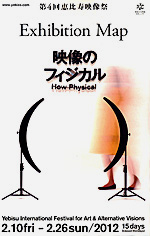 |
 |
|
| Yebisu International Festival for Art & Alternative Visions |
| 10 - 26 February 2012 |
Tokyo Metropolitan Museum of Photography
(Tokyo) |
 |
| This is the fourth Yebisu Festival. Centered around the Tokyo Metropolitan Museum of Photography, the event grows larger every year and involves a burgeoning number of collaborative exhibitions by galleries and other cultural institutions in the surrounding Ebisu district. With a gathering of artists and presentations that can only be described as wildly diverse, this year's edition, titled "How Physical," brought home the fact that the environment for film and video art has changed dramatically in recent years. Advances in digital media and display screen technology have greatly facilitated, and expanded the possibilities for, the creation of stunningly effective visual experiences. |
|
|
 |
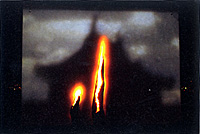 |
 |
|
| Kohei Suzuki: FEEDBACK 2010-2012 |
| 10 - 19 February 2012 |
LABORATORY
(Kyoto) |
 |
| Currently enrolled in the College of Image Arts and Sciences at Kyoto's Ritsumeikan University, Suzuki subtitled this show "Unconscious and Unspoken: Toward an Exploration of the Everyday." Featured were video records of a project in which he projected a film of landscapes onto a screen coated with wax, causing the screen to catch fire, and another project in which he placed orange traffic cones in outdoor settings and studied changes in the relationship between what one sees and one's awareness of the act of seeing. |
|
|
|
|

|
 |
 |
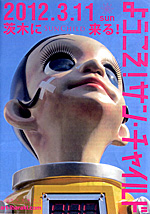 |
 |
| Kenji Yanobe Lecture: Until Sun Child Rises |
| 17 February 2012 |
Ibaraki Art Centre
(Osaka) |
 |
This lecture by multimedia artist Yanobe was a prelude to the March 11 unveiling of his monumental 6.2-meter-high sculpture Sun Child in front of Minami-Ibaraki station in the city of Ibaraki, outside Osaka. An intrepid-looking boy in a bright yellow radiation suit, the statue represents, according to Yanobe, a message to people struggling to recover from past disasters, encouraging them to "stand firm, look steadfastly forward, and strive for a world in which we no longer need protective clothing."
|
|
|
 |
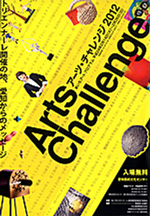 |
 |
| Arts Challenge 2012 |
|
|
Aichi Arts Center
(Aichi) |
 |
| For this open arts competition, Nagoya's Aichi Arts Center filled normally unused spaces outside its museum and galleries with works by the ten winners. Standouts included Nanako Kuroki, who glued cut-out figures of acquaintances to the windows of the building's viewing balcony; Tanishi K, who masqueraded as a reporter for "TNK News" in the Forum area, replaying her interviews in that guise with Nagoya citizens; Yasuko Tsuchida, who linked several hundred thousand safety pins together in a pile reminiscent of Mt. Fuji; and the paintings of Emiko Aoki, which lined a narrow corridor in the basement. |
|
|
|
|
|
|
|

|
 |
 |
 |
 |
| Seiji Honda: Mekurumeku (Dazzle) |
| 6 - 18 February 2012 |
Oto-gallery
(Osaka) |
 |
| Honda has until recently spent half of each year on board a tuna research ship, later exhibiting the watercolors and acrylics he produced while at sea. Lately, he says, he has remained on land, and his recent work reflects that. Instead of marine creatures, the gallery is full of small objects whose motifs range from birds and insects to mushrooms and even tapirs. There is an ethereal, evanescent, mystical quality to his work that inspires the imagination to take flight. |
|
|
 |
 |
| Hideki Yamada: Beauty |
| 6 - 18 February 2012 |
gallery wks.
(Osaka) |
 |
| On the entry wall hang a dozen or more small photos of flower petals or areas of a female body. Looking closer, one sees tiny black spots here and there on the images, as if someone had dropped a bit of black ink on them. Moving into the main gallery, one is confronted with a single large print on the main wall, an enlargement of a colorful assortment of roses, daisies and other flowers. Here, too, the blossoms are speckled with black blemishes, but overwhelmingly so. It's a powerful image of the dynamic between beauty and defilement. |
|

|
 |
 |
 |
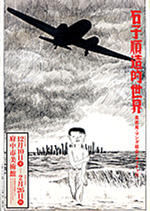 |
|
| The World of Junzo Ishiko: From Art via Manga to Kitsch |
| 10 December 2011 - 26 February 2012 |
Fuchu Art Museum
(Tokyo) |
 |
| Ishiko (1928-77) was an art critic who expanded his coverage to subcultural phenomena like manga and kitsch in the sixties and seventies. With the advent of otaku and neo-pop culture in recent years, his pioneering appreciation of such offbeat, "lowbrow" trends is enjoying a reappraisal. Featuring works he collected in these various genres, the show is divided into sections on art, manga, and kitsch. The subtitle provocatively suggests that art was no more than a starting point, and manga a waystation, en route to the ultimate destination of kitsch -- but that point of view actually seems more comprehensible now than it would have in Ishiko's day. |
|
|
 |
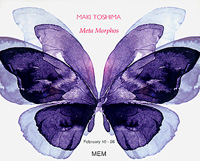 |
 |
| Maki Toshima: Meta.Morphos |
| 10 - 26 February 2012 |
MEM
(Tokyo) |
 |
| Inside a box-like frame hangs a painting of a butterfly -- which suddenly begins to move. No, it's not a living insect, but a CG-created composite image. The purple and metallic blue wings indicate that it's a Morpho. Over a dozen of these creatures are arranged in a neat row like trophies in a specimen case, but after a while they start flapping their wings, then disappear into thin air. The title of the show is a nice play on the species name and the notion of transformation. |
|
|
|
|
|
|
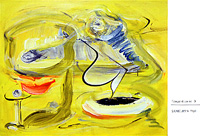 |
 |
| Yui Samejima: Tangent point 0 |
| 22 February - 11 March 2012 |
neutron tokyo
(Tokyo) |
 |
| Samejima's work comes in two disparate styles: flat paintings of sharply outlined white clouds against blue sky, and more painterly abstractions with thick slatherings of acrylic on canvas. Indeed, the two motifs might look good sharing the same frame. At 24, Kyoto-born Samejima already evinces an astounding mastery of her craft. These are impressive works, and bode very well for the artist's future. |
|
 |
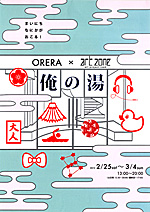 |
 |
| Ore no Yu (My Bath) |
| 25 February - 4 March 2012 |
art zone: art project room kyoto
(Kyoto) |
 |
| Peering into the glass-walled gallery one sees not the usual exhibition space, but a Japanese public bath, complete with patrons dipping their toes in the warm water. The bathhouse motif continues even on the second floor. This is the brainchild of ORERA, a group of students from Kyoto Zokei University of Art and Design, and their utilization of the temporarily-installed bathing facilities varies from day to day. When this reviewer paid a visit, a live painting of goldfish was in progress on the wall by the first-floor tub. Another wall featured the Mt. Fuji motif that is a fixture of every public bath in the country. |
|
|
|
|
 |
|